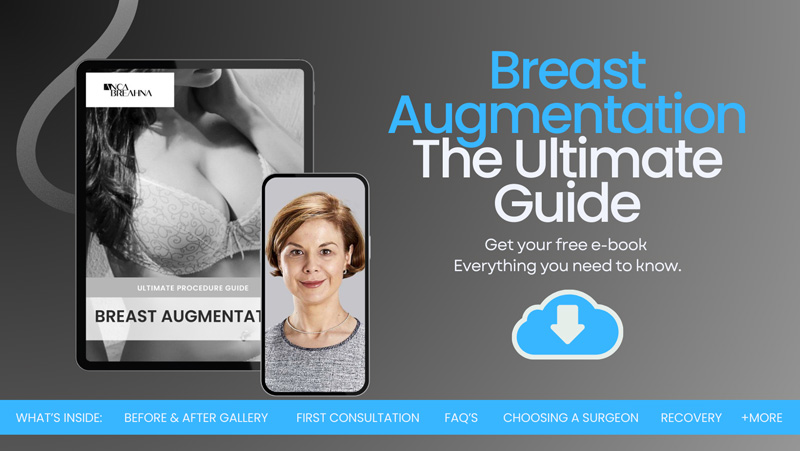
Treatment Options for Small Breasts, Hypomastia, and Amastia
Breast development is a complex process influenced by various genetic, hormonal, and environmental factors. It’s a key part of puberty and can continue into the early twenties. While there is a wide range of normal sizes, some may find their breasts to be smaller than they would prefer, leading to feelings of dissatisfaction. Hypomastia and amastia are two conditions characterised by the underdevelopment or absence of breast tissue.
In this blog, Chester Consultant Plastic Surgeon Anca Breahna aims to provide you with a comprehensive understanding of the biological, psychological, and social aspects of breast size concerns and treatment options for small breasts. Anca can successfully treat both Hypomastia and Amastia with breast augmentation (breast enlargement), a surgical intervention that uses breast implants to augment or reconstruct the affected breasts.
Download the Breast Augmentation Guide

What is Hypomastia?
Hypomastia is characterised by the underdevelopment of breast tissue. It’s not a disease but rather a variation in breast size that can affect anyone, regardless of health or hormonal balance. The primary indicator is simply a smaller breast size, which might be noticeable as early as adolescence when breasts begin to develop during puberty. If you’re curious about contributing factors and possible ways to address this, read more on the Causes and Solutions for a Flat Chest.
The impact of hypomastia extends beyond the physical. In a society where physical appearance often influences social interactions and personal perception, women with hypomastia might experience feelings of inadequacy or discomfort.
What is Amastia?
Amastia is a condition distinct from hypomastia, defined by the complete absence of one or both breasts and the nipple-areola complex. It is a rare congenital disorder that can occur either in isolation or as part of a syndrome affecting other parts of the body.
While hypomastia refers to the underdevelopment of breast tissue, resulting in smaller-than-average breasts, amastia is the absence of breast tissue entirely. Amastia can affect individuals in varying degrees, from the absence of a single breast to the lack of both breasts and nipples. This condition is noticeable from birth and is different from cases where breasts do not develop during puberty, a condition known as delayed breast development.
Causes and Genetic Factors of Amastia
The exact causes of amastia are still under research, but it is believed to be associated with genetic abnormalities or disruptions in embryonic development. In some instances, amastia occurs as part of a syndrome that may affect other body parts, indicating a genetic component to the condition. Environmental factors during pregnancy, such as exposure to certain medications or substances, may also play a role in its development.
Evaluating Your Breasts
If you have concerns about the size or development of your breasts, it may be time to seek professional advice. You might consider consulting a plastic surgeon if:
- You notice a significant difference in size between your breasts
- Your breasts have not developed by the late teens
- You’re experiencing discomfort or dissatisfaction with your breast size
Seeking medical advice is not only about exploring treatment options; it’s also about understanding your body and ensuring your health.
Your initial consultation will likely involve a detailed discussion about your medical history, concerns, and expectations. Anca may conduct a physical examination to assess your breast development and check for any abnormalities. Be prepared to discuss:
- Your general health and any medical conditions
- Family history of breast conditions
- Any medications you’re taking
- Your feelings and expectations regarding your breast size
Surgical Options for Enhancing Breast Size
For many, surgical intervention offers a more definitive solution to concerns regarding breast size. Breast augmentation surgery, involving the insertion of implants or the transfer of fat to increase breast volume, is among the most popular cosmetic procedures worldwide.
What is Breast Augmentation?
Breast augmentation surgery aims to enhance the size and shape of the breasts, often leading to a more proportional figure and a renewed sense of comfort in one’s appearance. The procedure involves either the placement of implants beneath the breast tissue or the transfer of your own fat to the breast area.
Breast implants are classified into two main types: silicone and saline. Silicone implants are filled with silicone gel, offering a texture that many find to be more like natural breast tissue. Saline implants, on the other hand, are filled with sterile salt water. They are inserted empty and then filled once in place, allowing for minor adjustments in size.
Each type of implant comes with its considerations regarding feel, appearance, and risk of complications. Anca will discuss these with you in detail, helping you choose the option that best meets your expectations and lifestyle.
Fat Transfer Breast Augmentation
An alternative to implants, fat transfer breast augmentation involves removing fat from other parts of your body—typically through liposuction—and injecting it into your breasts. This option appeals to those seeking a more natural enhancement, as it uses the patient’s own tissue. However, it generally provides a more subtle increase in size compared to implants.
The Breast Augmentation Procedure
Learning more about the step-by-step process, anaesthesia options, and incision choices can help you better understand the procedure, setting realistic expectations for those considering it.
The breast augmentation process typically involves the following steps:
- Anaesthesia: To ensure comfort and painlessness during the surgery, you will be given anaesthesia. The type, general or local with sedation, will be determined by Anca based on the specifics of your case.
- Making the Incision: Anca makes incisions in discreet locations to minimise visible scarring. Common sites include under the breast along the fold, around the areola, or under the arm.
- Inserting the Implant: Depending on your agreed plan, the implant can be placed either under the pectoral muscle or directly behind the breast tissue, over the pectoral muscle. Each placement option has its benefits and considerations, which Anca will have discussed with you.
- Closing the Incisions: Sutures, skin adhesive, or surgical tape close the skin incisions. Over time, these incision lines will fade and improve, although the degree of improvement varies among patients.
Immediately following the surgery, you will be taken to a recovery area where your health and wellbeing are closely monitored as the anaesthesia wears off.
Recovery and Post-Operative Care
After undergoing breast augmentation surgery to correct small breasts, understanding the recovery process and adhering to post-operative care instructions are key to achieving the best outcomes and minimising the risk of complications.
Immediate Aftercare
Following the procedure, you’ll likely experience soreness, swelling, and fatigue. These symptoms are normal and part of the body’s healing process. Anca will have applied bandages or dressings to the incision sites, and you may be given a support bra or garment to minimise swelling and support the breasts as they heal.
You’ll be advised on how to care for your breasts, medications to apply or take orally to aid healing and reduce the risk of infection, and when to return for a follow-up visit. It’s crucial to follow these instructions closely and attend all follow-up appointments.
Long-Term Recovery Tips
Recovery from breast augmentation surgery varies among patients, but here are some general tips:
- Rest and give your body time to heal, especially in the first few days after surgery
- Avoid strenuous activities and heavy lifting for at least a month or as advised by Anca
- Continue to wear the support garment as recommended to help shape the breasts and reduce swelling
- Be mindful of the incision sites, keeping them clean and dry, and monitoring for any signs of infection
Risks and Complications of Breast Augmentation for Hypomastia or Amastia
While breast augmentation is generally considered safe and has high satisfaction rates, it’s important to be aware of potential risks and complications. Being informed helps you make a well-considered decision and recognise signs that may necessitate prompt medical attention.
Common Post-Surgical Complications
Some of the more common complications associated with breast augmentation include:
- Infection: Though rare, infections can occur at the incision sites or around the implant, sometimes requiring antibiotic treatment or, in severe cases, removal of the implant.
- Capsular Contracture: This occurs when the scar tissue around the implant tightens, potentially causing pain and hardness. It might necessitate surgery to remove the scar tissue or replace the implant.
- Implant Leakage or Rupture: Both saline and silicone implants can break. If a saline implant leaks, the saline will be safely absorbed by the body, leading to a noticeable decrease in breast size. A ruptured silicone implant might not be as apparent but can cause breast pain or changes in contour or shape.
- Changes in Nipple and Breast Sensation: Some may experience increased sensitivity, while others might have numbness. These changes can be temporary or permanent.
FAQs about Treating Small Breasts
Can exercises targeting the chest area increase my breast size?
- While exercises that strengthen the chest muscles—like push-ups, bench presses, and chest flies—can improve the appearance of your breasts by making them appear more lifted and firmer, they do not increase breast size. Muscle growth in the chest can enhance the overall shape and posture, potentially giving the illusion of slightly larger breasts, but the breast tissue itself remains unchanged.
Are there natural remedies or herbs that can enlarge breasts?
- Some products and supplements claim to increase breast size using ingredients like fenugreek, fennel seeds, and saw palmetto, which are believed to have oestrogen-like effects on the body. However, there is limited scientific evidence to support these claims. It’s important to approach these remedies with caution, as their safety and efficacy are not well-documented, and they could potentially interact with other medications.
How do I choose between saline and silicone implants?
- The choice between saline and silicone breast implants depends on personal preference, body type, and desired outcome. Saline implants are filled with sterile salt water and can be adjusted during surgery, offering flexibility in size. Silicone implants are pre-filled with a silicone gel that many feel more closely mimics the feel of natural breast tissue. Discussing the pros and cons of each type with Anca can help you make an informed decision based on your specific goals and needs.
What is the average cost of breast augmentation surgery?
- The cost of breast augmentation can vary widely depending on your surgeon’s experience, the type of implants used, and the geographic location of the practice. The procedure usually includes fees for your surgeon, anaesthesia, hospital or surgical facility, post-surgery garments, and medical tests. It’s important to consider all these factors when budgeting for the surgery.
Can breast enlargement affect my ability to breastfeed in the future?
- Many women are able to breastfeed after breast augmentation surgery. However, certain surgical techniques and incision locations can potentially affect milk production and delivery. If future breastfeeding is a priority, discuss this with Anca during the consultation. Anca can tailor the surgical approach to minimise the risk of impacting breastfeeding capabilities.
Further Reading about Breast Augmentation with Consultant Plastic Surgeon Anca Breahna
- Read more about How to Get a Natural Looking Breast Augmentation Using Smaller Implants
- Read more about Breast Augmentation with Mentor Breast Implants
- Read more about Recovery Timeline after Breast Augmentation
- Read more about What is Breast Augmentation Surgery?
- Read more about When Can I Exercise after Breast Augmentation Surgery?
Medial References about Hypomastia/ Amastia
- Amastia – an overview – Science Direct
- Breast Disorders in Adolescence – PubMed
- Breasts | Human Malformations and Related Anomalies – Oxford Academic
- Hypoplastic Breast Anomalies in the Female Adolescent Breast – PubMed
Back to blog



 Ms Anca Breahna, PhD, MSc, FEBOPRAS, FRCS (Plast) is a highly regarded Consultant Plastic Surgeon specialising in the field of Aesthetic and Reconstructive Plastic Surgery. Anca performs a range of
Ms Anca Breahna, PhD, MSc, FEBOPRAS, FRCS (Plast) is a highly regarded Consultant Plastic Surgeon specialising in the field of Aesthetic and Reconstructive Plastic Surgery. Anca performs a range of 